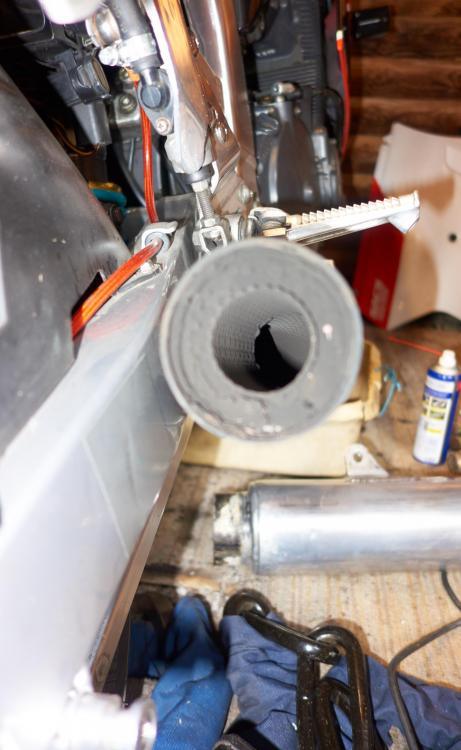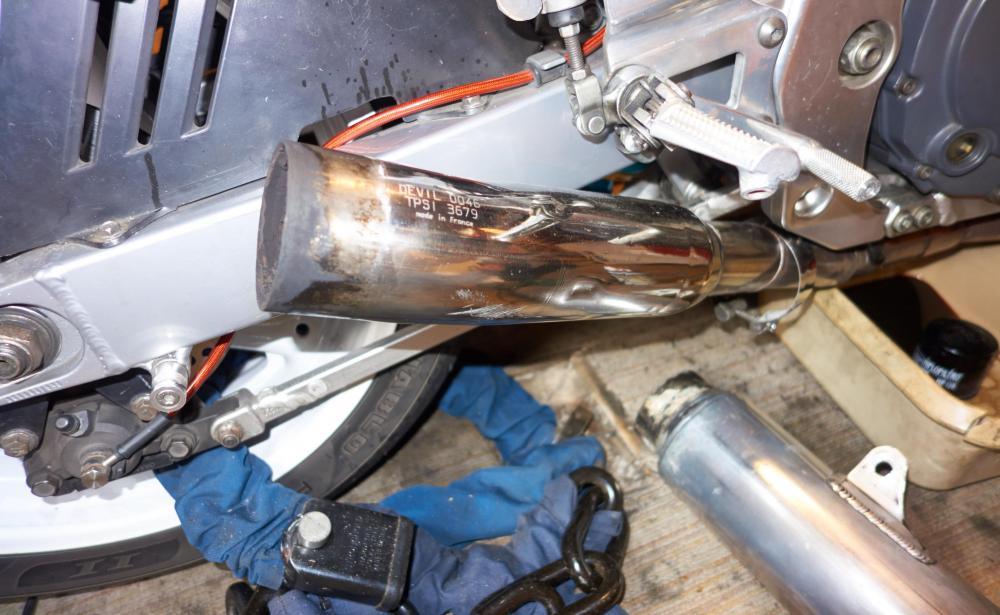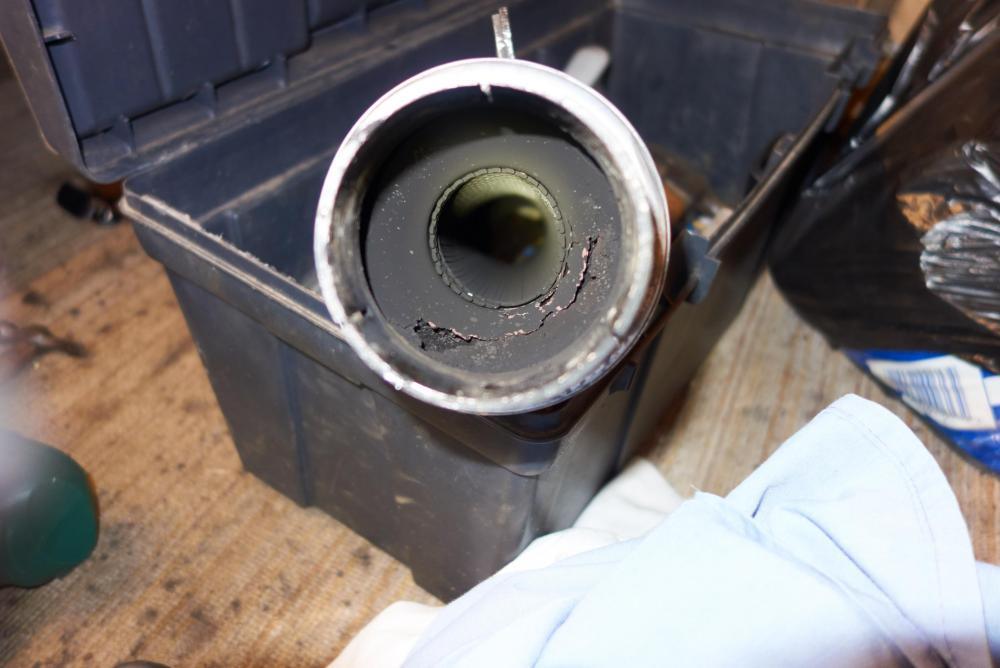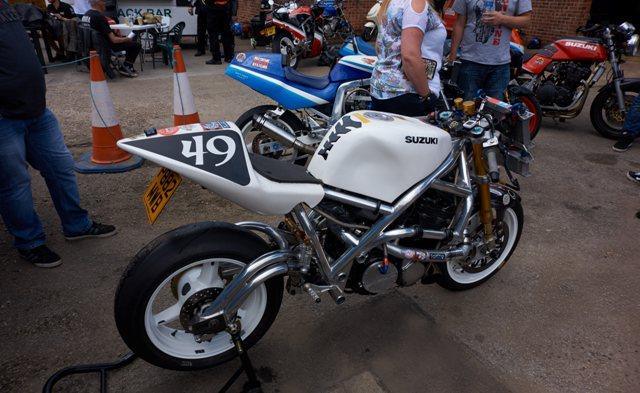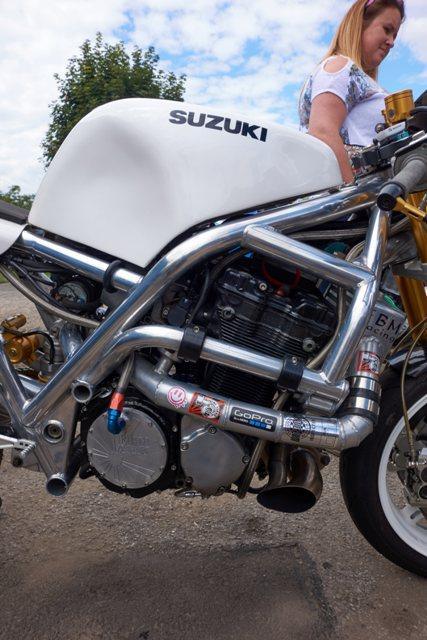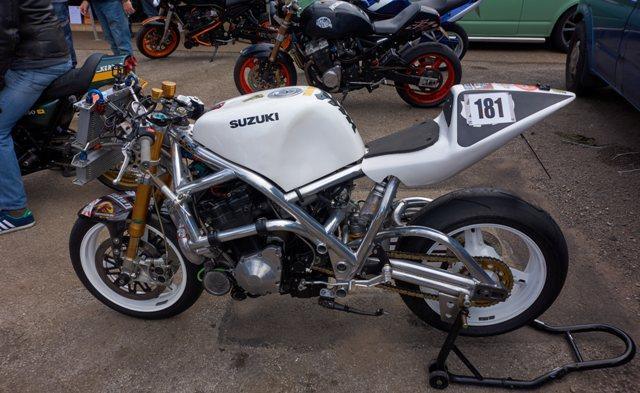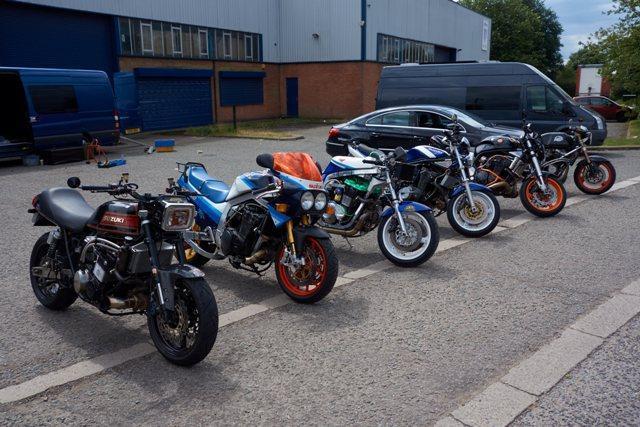

Crass
Members-
Posts
256 -
Joined
-
Last visited
Content Type
Profiles
Forums
Events
Everything posted by Crass
-
Before you give up you might want to try this. I've had a lot of trouble with braided lines and Tokicos, they seem way worse to get air free than Nissins. And no matter what you think, as you've bled them to death, your issue IS air. This is in the form of extremely small bubbles in the lines which are small enough to stick to the bores through surface tension. Bleeding in the conventional way either with the lever or a pressure bleeder won't shift them, the fluid just goes past them and they don't move. I've tried all the tying lever back etc, never works. So.. Take the brake calipers off and remove the pads. With the reservoir open start to push the pistons out with the brake lever. You will need to add more brake fluid to the reservoir as you go and go slowly, you don't want to pop a piston out. You will need to jam some of the pistons when they get a fair way out so that the others come out too. What you are trying to do here is get a good amount of fluid in that caliper. Now secure the calipers somehow (I never like to leave them hanging off brake lines), put the cap on the reservoir and leave overnight. Next day take cap off reservoir and start to push the pistons briskly back into the calipers. Watch how you go as the reservoir will fill up with fluid, which you will need to remove. When you have all the pistons back in put the pads in and refit the calipers. Top up reservoir and pump your brakes up, adding fluid as required. You should now have good brakes. This is a form of reverse bleeding and it works as the speed you push the fluid out of the calipers is too much for the surface tension of the air bubbles, they are dislodged and the fluid containing them is pushed out of the system at the reservoir where they vent to atmosphere.
-
Thread resurrection as I have now got round to removing the can, as I'm planning on replacing it with a A16 carbon fibre one. I can now see inside the link pipe and there are no baffles, it's just straight through with silencing material around the circumference, as you can see from the pics. The link pipe is pretty big bore at 76mm OD (but this is a bit misleading as the silencing is taking up a lot of that bore). I'll have to have a can inlet made up to measure with that size link pipe. The can itself weighs a ton. The A16 cans come with a removable baffle. As the fuelling was spot on with this exhaust on (not baffled) I suspect I will need to leave the baffle out of the A16 can to match the Devil. I'll try it with it in but I'm guessing it won't be right. I don't really like the sound of the Devil, it's a bit fluffy at other than high revs. I have an A16 can on another bike and it sounds good, performs well and has been very good quality.
-
-
Enjoyed it, nice ride out, nice bikes there. Awesome burger van - it's the burger van which makes or breaks any event
-
Planning on popping along about dinner time on me standard-ish Slingy. Had it dynoed and set it up a couple of years ago so won't be playing, just scoffing bacon, drinking tea and talking shit with OSS peeps.
-
Yeah, I've read the article, very good it is too. But that only applies in cases where the powerjets are not blanked off at the floatbowl, which in UK spec bikes they were. So it doesn't matter at any revs if the jets are blanked. What I'm getting at is that if the tubes are missing, so that there's four unplugged holes on the airbox side of the carb mouths, it makes no difference whether they are plugged up or not. Well, maybe it's better they are plugged to keep anything unfiltered from getting into the carbs, but performance-wise it makes no noticeabble difference.
-
Right, reporting back on this. No, it's made absolutely no difference whatsoever, bike is just as before. So, it would appear that if the tubes are disconnected / missing and not plugged you can just forget about it.
-
I've used them for bits, it's just a one man band. Sound bloke, no problems at all, would happily use him again. No extras VAT / import duty to pay on goods bought within the EU, you're paying Dutch VAT to the seller, nothing further owed.
-
If the weather's dry (look, I'm being honest, rather than saying I'll deffo come whatever and then not show) I'm planning on having a run through from Doncaster on my largely standard 1990 Slingy (few upgrade mods) to watch various Oldskoolers wave their whatsits at the dyno and enjoy looking at some awesome bikes. Won't be dynoing myself, have done that and it's nowt to brag about, just stock ordinariness. Burgervan destination swung it .
-
Here's a few thoughts which might help you to choose the way to go. First off, if you decide to replace it with another I'd suggest that if you are doing it to get an unscratched / unchipped one fitted you're almost inevitably going to be disappointed. Anything you pick up second hand is going to be cosmetically less than perfect - probably you'll get a tidy one but I'm guessing that if it's got scratches on it then it defeats the object of what you're doing. Then you have to ask what sort of state the bearings are in - you may end up having to replace these - more expense. My feeling is that if you already have a decent swinger but just need it cosmetically refreshing then stick with what you have and sort it. So, you have two options. Pretty sure you cannot get a powdercoat finish which matches the original satin / matt silver finish. But that will be the most durable finish if you don't mind the change - course, you're going to have to replace the bearings if you powdercoat. If you really want the OEM finish then I would look at taking the swinger down to a paint supplier to get them to match the colour. It's not an easy colour, I don't think you'll get an easy match off the shelf. Looking on the R S Bikepaints site for example, they don't list the swinger paint. As to what paint to use, on something like this I would be wary of a rattlecan job as I doubt it will stand up to stones etc. You probably want it doing by a decent paintshop who can produce a durable finish. So, two pack? That's if you're going to use the bike, if it's going to be a showpony and hardly ridden then durability isn't an issue. Just my thoughts. Personally I had my swinger powdercoated silver and stood the change in appearance as I wanted to use the bike and I wasn't convinced that any aftermarket paint was going to last the course in the long run. I'm happy with it but it's your call.
-
Just thought I'd post up this information in case it is of use to anyone, as I know the issue of camchain tensioner springs becoming tired with age is a well known one. I've just replaced my spring on a 750L Slingy as a precaution, as the motor is a little noisy and I have no information with the bike to suggest that the tensioner spring present is anything but original (bike has now done 35k). So, the pic shows the length of the removed spring as compared to a new one. New spring length is 95mm and the old one is 90mm (looks a bit different due to perspective on the photo but trust me). So there's the length of an as-new healthy spring if you remove yours and are wondering if it has been affected by creep. This spring is part no. is 12833-27A00 but I'm guessing it's a common part across a range of different years and models.
-
Not according to the Alphasports fiches
-
Well that's that done and I'll report back after the winter layup whether it has made any difference blocking them up. Bloody fiddly job as there's no way you can get pipes onto 2-4 with the carbs on the bike, you can't get in from either the top or bottom to fit them. So I bent a piece of wire at the tip, loaded it with silicone jointing compound and went in from the top, poking it down betwen the carb bodies to get under the open end of the brass pipes, then brought it up to fill the open ends. My way of thinking is that if air is getting in through these pipes it will be akin to having a slightly leaky airbox. Which woiuldn't be a good thing. If it makes no difference it has cost me nothing more than a couple of hours of time.
-
I've just tried blowing down the tube on #1 and it isn't plugged at the bellmouth end, so I doubt the others are either. I can see with a mirror that the metal pipes at the top of carbs 2-4 aren't plugged on the outside. I'll seal them up anyway, it's an easy job. What difference, if any, it will make to the carburation remains to be seen but the fact is that there isn't supposed to be a jet of air allowed to be pulled into the bellmouth via this route so I'll stop it and see.
-
Never thought I'd hear that on OSS Good idea about trying to give it a blowjob . Now why didn't I think of that? Will try on #1 with the pipe that already exists - you would think that if that one was plugged then it would follow that ones without pipes deffo would be.
-
So, I was reading the very interesting article on the Slingshot powerjet circuit and remembered seeing the rubber tube connecting the float bowl to the top of the carb on my 750L - easily visible on carb #1. Then yesterday I'm doing a deep clean of the bike as part of winter storage and whilst poking about in the bank of carbs I notice that the plastic elbow at the float bowl on carb #2 has the vertical part broken off and is missing the rubber tube. But wait - elbows all present and correct on carbs #3 and 4 but no tubes either. Hmm! I've had the bike almost two years now and did a pretty comprehensive stripdown resto on it. I know little to fuck all of the bike's previous history. What I do know is that it came with a K&N filter in the stock airbox and when I'd got it back on the road I had it dynoed to check the fuelling was set up ok - it was pretty much, just needed leaning a touch on the pilot circuit with the pilot fuel screw. Bike starts and runs fine all the way to the limiter, no running problems at all. So my question is, with three of the pipes missing what, if any, difference would this make to the running of the bike? My understanding is that it makes no odds at the float bowl end as the jets there are blanked off but at the top of the carb there should now be a outlet in the bellmouth open to atmosphere, right? Would this alter running noticeably, or is it just a case that it will be admitting a small jet of unfiltered air into the carb? It's a bit odd that one elbow is bust and three tubes are missing. Why would you piss about with these? This may suggest that someone has deliberately removed them - and plugged the bellmouth outlet? - I dunno. Like I say, I've no idea what, if any, work was done to the bike in connection with fitting the K&N (and it has an aftermarket exhaust) but it may have had some re-jetting done and the powerjet bits taken away. All I know is however they are set up the fuelling is correct. But if unplugged would give noticeable running issues then I guess that means they must be plugged. But if they are not plugged, should I? Not a problem to connect up a short length of plugged tube to the top of the carb if necessary. Thoughts?
-
Thanks for that
-
The fuel tap on my 750L will not turn to the prime position. It used to when I bought the bike about 18 months ago and it had been stored for several years prior to this. Now it won't any more. I suspect something old internally has swelled with the ethanol in the petrol and needs replacing. Thing is, looking at a lot of the rebuild kits advertised, 1) most seem to be just giving you bits for the vacuum operated diaphragm - that isn't the problem, and 2) I have heard some are cheap shite and don't last. Anyone bought a decent kit with all the bits to repair this kind of issue which has lasted?
-
When I restored my 750L Slingy I baulked at replacing the aftermarket smoked screen with an OEM one owing to the horrendous price - ~£260 but it has bugged me ever since. The replacement was ever so slightly taller which IMHO ruined the profile of the front end, plus I don't like smoked screens. So when Suzuki added the Slingies to the Vintage Parts Programme, and made them Bike of the Month last month and this, knocking 50% off the screen price, and with the OSS discount at Robinsons I though fuck it, just do it. Still an eyewatering price for a bit of plastic mind you but at least my piss has stopped boiling now.
-
It deffo is a 4-2-1. Spike - you saying Devil made a system for the 750W?
-
No, doesn't matter as such, I was wanting to know out of interest what it is actually from if it is true it's not made for the 750. But as Doobs says, the 1100 zorsts I've seen on 750s hang much lower off the sump and foul the bellypan - no probs on mine, which makes me think this is for the 750. But they're not supposed to exist . Maybe the headers don't go with the can? Genuine 750 stainless headers from something else with the link pipe and can (from an 1100?) grafted on?
-
I'm interested to know what the Devil exhaust on my 750L Slingy is off as I've been told that Devil never made a system for this bike. It's a 4-2-1 with stainless headers, link pipe and can seem to be aluminium. It's unbaffled but not particularly rude at town revs, although it gets nicely fruity higher up. The link pipe is engraved 'DEVIL 0046 TPSI 3679 Made in France' and the can is stamped 'E13 4738' on the bracket. It's not marked as a race system but neither does it have E / BSAU markings. Any ideas?
-
Well I tried Pirelli's recommendations for an L model Slingy of 36/42 and the bike felt shite compared to Suzuki's recommendation of 33/36, which I've been running for about 1500 miles now. Rear end too harsh and skipping off bumps, front end white lining and feeling like it's flopping into turns. Overall a very vague and not-confidence inspiring feel to the bike. I use it mainly on B roads and country backroads which can challenge suspension set up. Front forks have been recently serviced and set up by Steve Jordan Suspension Centre and the rear has a Nitron Sport shock on built for my weight - at 33/36 it handled mint. After 20 miles I'd had enough and took the extra pressure out and bingo! bike handles again. So IMHO it's not as simple as just following what the tyre manufacturer says, try the Suzuki setting too. As a point of interest Pirelli's recommendation for the same tyres on my '94 ZXR 400 are exactly the same as Kawasaki's recommendation - 32/36 - and that's what I've always run. Yet for the Slingy they pump the pressure way up. Odd. Doesn't do it for me.
-
Useful post. Never crossed my mind not to use the bike manufacturer's recommendations, just assumed they would know best for their machine. Hadn't thought about the change in tyres over this period. I've been running 33/36 in a 750L on Pirelli Diablo Rosso II, though have to say I've not had a problem. Maybe they will square off quicker? Just checked Pirelli website and it says 36/42. Will try what they say and see what it feels like.


